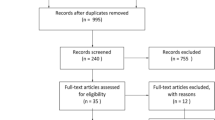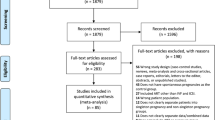Abstract
Purpose
The objective of this meta-analysis is to determine whether there is a higher incidence of preeclampsia (PE) in pregnancies achieved by oocyte donation (OD) compared with pregnancies achieved by in vitro fertilization with autologous oocytes (IVF).
Methods
A systematic review was performed to identify relevant studies published from January 1994 until April 2015 with at least an abstract in English using PubMed, ISI Web of Knowledge, and clinicaltrials.gov. The 11 studies included in this systematic review were retrospective and prospective cohort studies of women reporting results on the association between oocyte donation vs. in vitro fertilization (exposure) and preeclampsia (outcome).
Results
Oocyte donation is a risk factor for the development of PE compared to IVF cycles, with a weighted OR of 3.12 under a fixed effects method (FEM: no heterogeneity between the studies). The weighted OR under a random effects model was 2.9 (REM: heterogeneity between the studies). The meta-regression analysis showed that neither multiple pregnancies (estimate = 0.08; p = 0.19) nor patient age (estimate = −2.29; p = 0.13) significantly explained the variability of the effect of oocyte donation on PE. Q statistic was 12.78 (p = 0.237), suggesting absence of heterogeneity between the studies.
Conclusions
Pregnancies achieved by oocyte donation confer a threefold increase in the likelihood of developing PE than those achieved by in vitro fertilization with own oocytes. Physicians should be aware of this risk in order to both counsel patients and monitor pregnancies accordingly.



Similar content being viewed by others
References
Smith GN, Walker M, Tessier JL, Millar KG. Increased incidence of preeclampsia in women conceiving by intrauterine insemination with donor versus partner sperm for treatment of primary infertility. Am J Obstet Gynecol. 1997;177(2):455–8.
Klatsky PC, Delaney SS, Caughey AB, Tran ND, Schattman GL, Rosenwaks Z. The role of embryonic origin in preeclampsia: a comparison of autologous in vitro fertilization and ovum donor pregnancies. Obstet Gynecol. 2010;116(6):1387–92.
Kyrou D, Kolibianakis EM, Devroey P, Fatemi HM. Is the use of donor sperm associated with a higher incidence of preeclampsia in women who achieve pregnancy after intrauterine insemination? Fertil Steril. 2010;93(4):1124–7. doi:10.1016/j.fertnstert.2008.12.021.
American College of O, Gynecologists, Task Force on Hypertension in P. Hypertension in pregnancy. Report of the American College of Obstetricians and Gynecologists' Task Force on Hypertension in Pregnancy. Obstet Gynecol. 2013;122(5):1122–31. doi:10.1097/01.AOG.0000437382.03963.88.
Flenady V, Koopmans L, Middleton P, Froen JF, Smith GC, Gibbons K, et al. Major risk factors for stillbirth in high-income countries: a systematic review and meta-analysis. Lancet. 2011;377(9774):1331–40. doi:10.1016/S0140-6736(10)62233-7.
Redman CW, Sargent IL. Immunology of pre-eclampsia. Am J Reprod Immunol. 2010;63(6):534–43. doi:10.1111/j.1600-0897.2010.00831.x.
Garrido N, Bellver J, Remohi J, Alama P, Pellicer A. Cumulative newborn rates increase with the total number of transferred embryos according to an analysis of 15,792 ovum donation cycles. Fertil Steril. 2012;98(2):341–6 e1-2. doi:10.1016/j.fertnstert.2012.04.039.
Group ECW. Failures (with some successes) of assisted reproduction and gamete donation programs. Hum Reprod Update. 2013;19(4):354–65. doi:10.1093/humupd/dmt007.
Kupka MS, Ferraretti AP, de Mouzon J, Erb K, D'Hooghe T, Castilla JA, et al. Assisted reproductive technology in Europe, 2010: results generated from European registers by ESHRE. Hum Reprod. 2014;29(10):2099–113. doi:10.1093/humrep/deu175.
van der Hoorn ML, Lashley EE, Bianchi DW, Claas FH, Schonkeren CM, Scherjon SA. Clinical and immunologic aspects of egg donation pregnancies: a systematic review. Hum Reprod Update. 2010;16(6):704–12.
Gundogan F, Bianchi DW, Scherjon SA, Roberts DJ. Placental pathology in egg donor pregnancies. Fertil Steril. 2010;93(2):397–404.
Keegan DA, Krey LC, Chang HC, Noyes N. Increased risk of pregnancy-induced hypertension in young recipients of donated oocytes. Fertil Steril. 2007;87(4):776–81.
Le Ray C, Scherier S, Anselem O, Marszalek A, Tsatsaris V, Cabrol D, et al. Association between oocyte donation and maternal and perinatal outcomes in women aged 43 years or older. Hum Reprod. 2012;27(3):896–901.
Salha O, Sharma V, Dada T, Nugent D, Rutherford AJ, Tomlinson AJ, et al. The influence of donated gametes on the incidence of hypertensive disorders of pregnancy. Hum Reprod. 1999;14(9):2268–73.
Wolff KM, McMahon MJ, Kuller JA, Walmer DK, Meyer WR. Advanced maternal age and perinatal outcome: oocyte recipiency versus natural conception. Obstet Gynecol. 1997;89(4):519–23.
Soderstrom-Anttila V, Tiitinen A, Foudila T, Hovatta O. Obstetric and perinatal outcome after oocyte donation: comparison with in-vitro fertilization pregnancies. Hum Reprod. 1998;13(2):483–90.
Levron Y, Dviri M, Segol I, Yerushalmi GM, Hourvitz A, Orvieto R, et al. The ‘immunologic theory’ of preeclampsia revisited: a lesson from donor oocyte gestations. Am J Obstet Gynecol. 2014;211(4):19.
Myatt L, Redman CW, Staff AC, Hansson S, Wilson ML, Laivuori H, et al. Strategy for standardization of preeclampsia research study design. Hypertension. 2014;63(6):1293–301. doi:10.1161/HYPERTENSIONAHA.113.02664.
Woldringh GH, Frunt MHA, Kremer JAM, Spaanderman MEA. Decreased ovarian reserve relates to pre-eclampsia in IVF/ICSI pregnancies. Hum Reprod. 2006;21(11):2948–54. doi:10.1093/humrep/del155.
Paulson RJ, Boostanfar R, Saadat P, Mor E, Tourgeman DE, Slater CC, et al. Pregnancy in the sixth decade of life: obstetric outcomes in women of advanced reproductive age. JAMA. 2002;288(18):2320–3.
Yogev Y, Melamed N, Bardin R, Tenenbaum-Gavish K, Ben-Shitrit G, Ben-Haroush A. Pregnancy outcome at extremely advanced maternal age. Am J Obstet Gynecol. 2010;203(6). doi:10.1016/j.ajog.2010.07.039.
Porreco RP, Harden L, Gambotto M, Shapiro H. Expectation of pregnancy outcome among mature women. Am J Obstet Gynecol. 2005;192(1):38–41.
Shrim A, Levin I, Mallozzi A, Brown R, Salama K, Gamzu R, et al. Does very advanced maternal age, with or without egg donation, really increase obstetric risk in a large tertiary center? J Perinat Med. 2010;38(6):645–50.
Stroup DF, Berlin JA, Morton SC, Olkin I, Williamson GD, Rennie D, et al. Meta-analysis of observational studies in epidemiology: a proposal for reporting. Meta-analysis Of Observational Studies in Epidemiology (MOOSE) group. JAMA. 2000;283(15):2008–12.
Wells G, Shea B, O'Connell D, Peterson J, Welch V, Losos M et al. The Newcastle-Ottawa Scale (NOS) for assessing the quality of nonrandomised studies in meta-analyses. [http://www.ohri.ca/programs/clinical_epidemiology/oxford.asp]. Accessed 19/2/2015.
Egger M, Davey Smith G, Schneider M, Minder C. Bias in meta-analysis detected by a simple, graphical test. BMJ. 1997;315(7109):629–34.
Sterne J. Meta-analysis in Stata: an updated collection from the Stata Journal. College Station (Texas): Stata Press; 2009.
Schwarzer G. Meta-analysis. The R Foundation for Statistical Computing. 2007.
Hagman A, Loft A, Wennerholm U-B, Pinborg A, Bergh C, Aittomaki K, et al. Obstetric and neonatal outcome after oocyte donation in 106 women with Turner syndrome: a Nordic cohort study. Hum Reprod. 2013;28(6):1598–609. doi:10.1093/humrep/det082.
Krieg SA, Henne MB, Westphal LM. Obstetric outcomes in donor oocyte pregnancies compared with advanced maternal age in in vitro fertilization pregnancies. Fertil Steril. 2008;90(1):65–70.
de Graaff AA, Land JA, Kessels AG, Evers JL. Demographic age shift toward later conception results in an increased age in the subfertile population and an increased demand for medical care. Fertil Steril. 2011;95(1):61–3. doi:10.1016/j.fertnstert.2010.05.013.
Blickstein I. Motherhood at or beyond the edge of reproductive age. Int J Fertil Women's Med. 2003;48(1):17–24.
Pal L, Santoro N. Age-related decline in fertility. Endocrinol Metab Clin N Am. 2003;32(3):669–88.
Roberge S, Villa P, Nicolaides K, Giguere Y, Vainio M, Bakthi A, et al. Early administration of low-dose aspirin for the prevention of preterm and term preeclampsia: a systematic review and meta-analysis. Fetal Diagn Ther. 2012;31(3):141–6. doi:10.1159/000336662.
Thomopoulos C, Tsioufis C, Michalopoulou H, Makris T, Papademetriou V, Stefanadis C. Assisted reproductive technology and pregnancy-related hypertensive complications: a systematic review. J Hum Hypertens. 2013;27(3):148–57. doi:10.1038/jhh.2012.13.
Hernandez-Diaz S, Werler MM, Mitchell AA. Gestational hypertension in pregancies supported by infertility treatments: role of infertility, treatments, and multiple gestations. Fertil Steril. 2007;88(2):438–45. doi:10.1016/j.fertnstert.2006.11.131.
Madeja Z, Yadi H, Apps R, Boulenouar S, Roper SJ, Gardner L, et al. Paternal MHC expression on mouse trophoblast affects uterine vascularization and fetal growth. Proc Natl Acad Sci U S A. 2011;108(10):4012–7. doi:10.1073/pnas.1005342108.
Hiby SE, Walker JJ, O'Shaughnessy KM, Redman CW, Carrington M, Trowsdale J, et al. Combinations of maternal KIR and fetal HLA-C genes influence the risk of preeclampsia and reproductive success. J Exp Med. 2004;200(8):957–65. doi:10.1084/jem.20041214.
Tilburgs T, Roelen DL, van der Mast BJ, de Groot-Swings GM, Kleijburg C, Scherjon SA, et al. Evidence for a selective migration of fetus-specific CD4 + CD25bright regulatory T cells from the peripheral blood to the decidua in human pregnancy. J Immunol. 2008;180(8):5737–45.
Schonkeren D, Swings G, Roberts D, Claas F, de Heer E, Scherjon S. Pregnancy close to the edge: an immunosuppressive infiltrate in the chorionic plate of placentas from uncomplicated egg cell donation. PLoS One. 2012;7(3):27.
Pecks U, Maass N, Neulen J. Oocyte donation: a risk factor for pregnancy-induced hypertension: a meta-analysis and case series. Dtsch Arztebl Int. 2011;108(3):23–31.
Kelkar RL, Meherji PK, Kadam SS, Gupta SK, Nandedkar TD. Circulating auto-antibodies against the zona pellucida and thyroid microsomal antigen in women with premature ovarian failure. J Reprod Immunol. 2005;66(1):53–67. doi:10.1016/j.jri.2005.02.003.
Alecsandru D, Garrido N, Vicario JL, Barrio A, Aparicio P, Requena A, et al. Maternal KIR haplotype influences live birth rate after double embryo transfer in IVF cycles in patients with recurrent miscarriages and implantation failure. Hum Reprod. 2014;29(12):2637–43.
Acknowledgments
The authors would like to thank M.J. Lopez of Clínica EUGIN, Barcelona 08029, Spain, for the help in selecting the studies included.
Author information
Authors and Affiliations
Corresponding author
Ethics declarations
Conflict of interest
The authors declare that they have no conflict of interest.
Sources of funding
None.
Additional information
Capsule Pregnancies achieved by oocyte donation confer a threefold increase in the likelihood of developing PE than those achieved by in vitro fertilization with own oocytes.
Electronic supplementary material
Below is the link to the electronic supplementary material.
Supplementary Table 1
Influence analysis under the random effect model. Of note, the exclusion of any of the studies did not relevantly change the weighted ORs. (DOCX 189 kb)
Supplementary Figure 1
Bubble graph with fitted meta-regression line of multiple pregnancy rate (prevalence difference between oocyte donation and IVF groups) against log-OR for PE. (GIF 12 kb)
Supplementary Figure 2
Bubble graph with fitted meta-regression of age (difference between oocyte donation and IVF means) against log-OR for PE. (GIF 11 kb)
Supplementary Information 1
The search equation used in this systematic review. (DOCX 13.5 kb)
Rights and permissions
About this article
Cite this article
Blázquez, A., García, D., Rodríguez, A. et al. Is oocyte donation a risk factor for preeclampsia? A systematic review and meta-analysis. J Assist Reprod Genet 33, 855–863 (2016). https://doi.org/10.1007/s10815-016-0701-9
Received:
Accepted:
Published:
Issue Date:
DOI: https://doi.org/10.1007/s10815-016-0701-9




